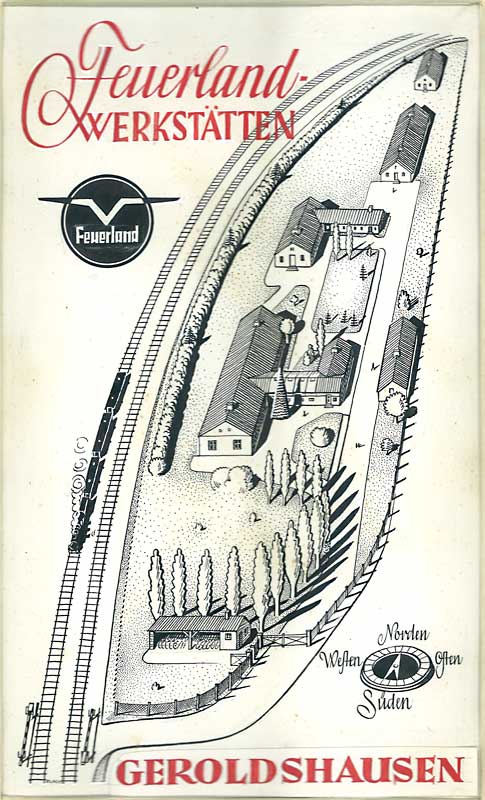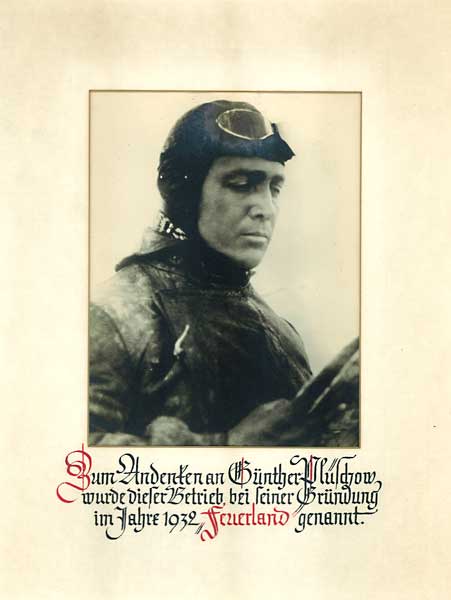History
The foundation of the company Feuerland-Werkstätten was in the year 1932 through the engineer Mr. Ernst Beilhack. As an appliance- and machinery- company it dealt with the production of fuel-pumps and parts for gas-stations. In the year 1938 also military parts – mainly for the aircraft-sector – were added to the production-line.
During the war also electronic parts for rockets were produced, ca. 350 employees were working in shifts. After the war the machines were dismantled by the allies and other machines were made useless.
Present
The rebuilding after the war was connected with the search for new products. Feuerland started with the production of punching-tools for mechanical parts, embossing-, grinding- and franking-machines and tape-recorders for the film-industry.
- 1932: The origin of the name „Feuerland“ Open or Close
-
1932- 1939: Company foundation and pre-war Open or Close
In 1932 Ernst Beilhack fulfilled his dream of self-employment and founded the “Feuerland-Arbeitsgemeinschaft”. With marginal equipment -only a drilling and a lathe machine- he began with the production of aircraft models that were sold in toyshops.
At the same time Beilhack worked for different companies that hired him for the reorganization of their processes. So did the company “Schwelmer Eisenwerk”. In return for his duties they helped Beilhack finding an appropriate building for Feuerland. As a result the company moved from Würzburg to Langerfeld.
However, Beilhack wanted to move back the company to his home town shortly afterwards. Therefore he was looking for a location with plenty of space close to a railway station. He finally found this location in Geroldshausen. In 1936 the company moved to its present location.
-
1939-1945: The development of Feuerland during the war Open or Close
 As the company received the initial order to produce individual parts for rapid fire guns, it was officially declared as a company for armaments. Feuerland produced controlling elements for any kinds of aircrafts and carburetors for carrier bombers. As time went by the company constantly grew bigger and Beilhack purchased the “Geyerhof” in Ingolstadt that was originally meant for private use.
As the company received the initial order to produce individual parts for rapid fire guns, it was officially declared as a company for armaments. Feuerland produced controlling elements for any kinds of aircrafts and carburetors for carrier bombers. As time went by the company constantly grew bigger and Beilhack purchased the “Geyerhof” in Ingolstadt that was originally meant for private use.As the commando for armament asked the company to produce the „Jensch“ device for U-boats in secret, the Geyerhof became a location of production and beyond that home for 50 caught French and 50 female Russian workers.
Meanwhile the company had a workforce of 350 workers that helped among other things to produce the rockets V1 und V2 known as Hitler’s miracle weapons.
-
1945-1955: Reconstruction after the war Open or Close
After the war had ended the company was in a bad condition. Ernst Beilhack had to rebuild the company completely. The first order came from the military government. They asked Feuerland to produce orthopedic devices for wounded soldiers. In order to gain capital for rebuilding the company Beilhack began to repair broken agricultural machines and to rent part of his company.
-
1955-1981: Extension of product range Open or Close
Further on Feuerland produced instruments for measuring the flow of petrol and oil at stations. In the 1950s Feuerland took over the production of railway shock absorbers from Fichtel&Sachs, as the amount of orders was too small for the company’s size and therefore inefficient. By exporting pressrod for cable shoe to the Netherlands, France and Sweden Feuerland finally entered the international market.
Moreover Feuerland started to produce punching tools for mechanical parts and embossing machines. Another product line was represented by centreless circular grinders, franking machines as well as sound recording equipment for film production.
- 1981-1998: Change in leadership and first certification Open or Close
-
1998 until today: Feuerland Werkstätten today Open or Close
Besides the new production of shock absorbers also their remanufacturing is a major part of Feuerland’s business today. This includes the reconditioning of any kinds of shock absorbers for all prevalent systems of locomotives, carriages as well as metros. In order to be able to remanufacture them Feuerland developed a testing bay for shock absorbers.
Apart from forgings and cast parts Feuerland also produces welded assemblies and various production parts. As Feuerland is a supplier of the Deutsche Bahn AG the range of products for rail vehicles is constantly extended.
A few years ago Feuerland developed an evacuation bar that meanwhile can be found in all ICE’s of DB AG and in trains of foreign railway providers.
In 2014 Feuerland again received the Q1- certificate of DB AG for rated product safety. This certifies Feuerland the highest capability for quality as a supplier. In 2013 the company took successfully part in the audits for quality and environmental managements systems in compliance with ISO 9001:2015 and ISO 14001:2015. Since 15 years the company disposes of a welding admission in compliance with DIN EN 15085-2 CL1.




